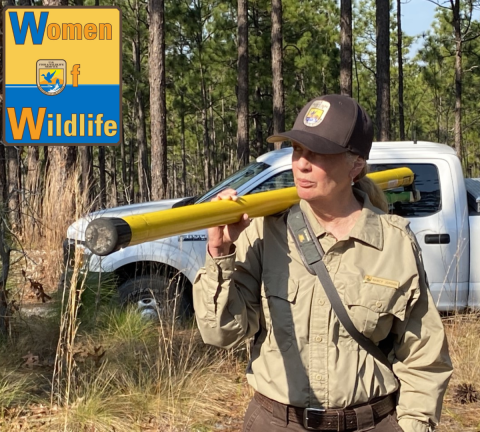When looking to grow their populations and making their locations desirable to diverse audiences, city planners consider what they can do to entice new neighbors to move in, while at the same time creating safe, welcoming spaces where existing residents will want to stay – for a long time, maybe forever.
That’s exactly what U.S. Fish and Wildlife Service Biologist Nancy Jordan does. She creates a haven, a home, for the red-cockaded woodpeckers who nest at the Carolina Sandhills National Wildlife Refuge in McBee, South Carolina.
Working with the staff at Sandhills, Jordan helps keep an eye out for the endangered woodpecker and the species’ response to the team’s efforts to manage the longleaf pine-wiregrass ecosystem. The woodpeckers thrive in that environment.
“Monitoring species response is important for documenting achievements toward [the Service’s] goal of using science-based approaches to attain sustainable ecosystems and species populations,” the Wilton Manors, Florida, native said.
The Service listed the red-cockaded woodpecker as endangered in 1970. Thanks in part to the Endangered Species Act, the red-cockaded woodpecker population has grown – and continues to do so – not only at Sandhills but throughout the Southeast Region as well.
For the last 50 years, the Endangered Species Act has helped protect fish, wildlife, and plants listed by the Service as threatened or endangered. The act, which observes its golden anniversary in 2023, provides protocols to add and remove species from the threatened and endangered lists; prepares and implements plans for their recovery; and allows for and facilitates interagency cooperation.
As the biologist on staff, Jordan applies her expertise, all the knowledge gained as an undergraduate at Florida State and in graduate school at Clemson – plus her 18 years of experience with the Service – helping recover the red-cockaded woodpecker population at Sandhills. Her efforts include installing “subsidized housing,” or artificial cavities in the desirable longleaf pines. This entices and makes it easy for the woodpeckers and their familial clusters to move in and call Sandhills home.
Her commitment to creating a refuge for the endangered bird, spans beyond the 45,000 acres at Sandhills. Jordan works closely with fellow biologists throughout the Service, exploring how best to support the species. She also donates red-cockaded woodpeckers to smaller populations and facilitates reintroductions that enhance recovery range-wide.
But that’s not all Jordan does to help meet the Service’s mission of “working with others to conserve, protect, and enhance, fish, wildlife, plants, and their habitats for the continuing benefit of the American people.”
“While Nancy Jordan is considered an expert in red-cockaded woodpecker biology and management, she is also extremely knowledgeable about other open pine-grassland species,” says Lyne Askins, manager of the Carolina Sandhills Refuge. “She recognized upon coming to the refuge in 2007 that we knew a lot about red-cockaded woodpeckers but not a lot about the other open pine-grassland species that inhabit the refuge. She set out to design monitoring surveys for other species to fill information gaps. I appreciated how she went about designing these surveys. It’s a very efficient way to enroll the entire staff, volunteers and interns in collecting information and evaluating whether our management techniques are benefitting more than just [red-cockaded woodpeckers].
But that’s not all!
Jordan, who was selected as the Service’s Southeast Region Biologist of the Year in 2017, supports the refuge’s prescribed burn prescribed burn
A prescribed burn is the controlled use of fire to restore wildlife habitat, reduce wildfire risk, or achieve other habitat management goals. We have been using prescribed burn techniques to improve species habitat since the 1930s.
Learn more about prescribed burn efforts. These activities enhance the red-cockaded woodpeckers’ and other species’ habitats. At one point, she served as part of the team’s in-flight helicopter crew.
Jordan also spearheads the refuge’s cooperative quail project with the SC Department of Natural Resources. The partners aim to increase the number of quail in a designated quail focal area on the refuge.
To that end, she worked closely with colleagues at the SCDNR, developing a five-year Quail Management Plan. Askins explains that the refuge exceeded its goal in only four years. Jordan is now working on the next five-year plan for the area.
“While employees with her experience might be thinking about retirement or resting on their prior successes, Nancy is forward-thinking and always eager to know more about the species that inhabit the refuge,” Askins says.
Whether recovering endangered species, monitoring others, creating the best habitat for the wildlife and plants on the refuge, collaborating with conservation partners or introducing the public to the Service through engaging recreational activities on Carolina Sandhills National Wildlife Refuge or interactive educational programs, Jordan remains a passionate team player.
“After working here for 14 years, I enjoy seeing the longleaf pine-wiregrass forest change through the seasons and to see the positive impact our habitat management has on the species that call this place their home,” she says. “I feel proud that our efforts here contribute to longleaf pine restoration across the Southeast, and I totally enjoy sharing my enthusiasm for this ecosystem and refuge with the public.”
Editor’s note: During Women’s History Month, the U.S. Fish and Wildlife Service celebrates the accomplishments and commitment of women throughout the organization. The Women of Wildlife, or WOW, story series highlights some of the women serving in the Southeast Region.







